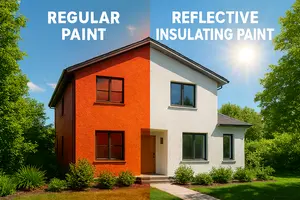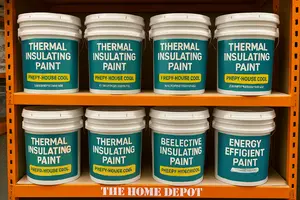When people think about reducing energy bills, the first things that come to mind are insulation, solar panels, or energy-efficient windows. But what if a simple coat of energy saving paint could make your house cooler in summer, warmer in winter, and more eco-friendly all year long?
This innovative solution is gaining attention worldwide, especially among homeowners who want affordable, eco-conscious upgrades. Let’s dive into how energy saving paints work, their pros and cons, and whether they’re worth the hype.
What Is Energy Saving Paint?
Energy saving paint, sometimes called insulating paint, is specially formulated with microscopic ceramic or glass beads that reflect heat and improve thermal efficiency. Unlike traditional paints that mainly provide color and protection, this paint acts as an extra layer of insulation.
In practical terms, it means your walls can help regulate indoor temperatures, lowering your reliance on air conditioning or heating systems.
Exterior Paint With Insulation Properties
One of the most popular uses is exterior paint with insulation properties. These paints are designed to reflect solar radiation and prevent excessive heat absorption into your walls.
- In hot climates, this type of exterior house paint that insulates can keep homes cooler and reduce cooling costs.
- In colder regions, insulating coatings slow down heat loss, so less warmth escapes through walls.

If you’re already planning an outdoor paint job, switching to this type of paint offers both protection and efficiency, a two-in-one benefit.
Energy Efficient Paints for House Interiors
While exterior coatings get much attention, insulating paint for interior walls also plays a big role. Applying it indoors helps keep rooms at a stable temperature, especially in older houses with poor insulation.
Homeowners have reported noticeable comfort improvements and reduced energy use after using these paints in living rooms, bedrooms, and basements.
For example, if you’re painting a ceiling, pairing insulating paint with the right best ceiling paint color can improve aesthetics and energy efficiency at once.
Does Insulation Paint Really Work?
A common question is: does insulation paint really work?
The answer depends on expectations. Scientific tests show that insulating paints may not completely replace traditional insulation, but they do contribute to better thermal performance. Think of them as an extra layer of efficiency, not a full substitute for insulation boards or fiberglass.
They’re most effective when combined with other energy-saving measures like sealing air leaks, choosing the best way to paint a ceiling, or applying reflective roof coatings such as solar reflective roof paint.
Thermal Insulating Paint Options
Many big retailers now offer these paints, making them more accessible than ever. For instance, thermal insulating paint Home Depot has become a go-to option for DIY homeowners in North America.

These paints come in multiple finishes and can be tinted to match your existing design choices. Some are marketed specifically as paint that keeps house cool, making them especially appealing in regions with long summers.
Where Insulated Paints Are Used in Houses
Insulated paint used in houses isn’t limited to just walls. Homeowners also apply it to:
- Ceilings (to reduce rising heat loss)
- Attics (for extra thermal reflection)
- Garages and basements (where traditional insulation is harder to install)
Pairing insulating paint with proper prep steps such as cleaning walls before painting helps maximize its effect.
Energy Saving Painting and Environmental Impact
When we talk about energy saving painting, it’s not just about comfort — it’s about the environment. Using these paints reduces overall electricity and heating consumption, cutting greenhouse gas emissions.
That’s why many eco-campaigns use phrases like:
- Energy saving is environmental saving painting
- Saving energy is saving environment painting
Schools even organize energy saving is environment saving painting competitions, encouraging children to create posters like:
- Painting on topic energy saving is environment saving
- Paintings on energy saving is environment saving
These awareness efforts remind us that even small lifestyle changes, like choosing the right wall paint, contribute to a bigger environmental goal.
Pros and Cons of Energy Saving Paint
Like any innovation, energy saving paints have benefits and limitations.
Pros:
- Lower cooling and heating costs
- Easy application (same process as regular paint)
- Works indoors and outdoors
- Eco-friendly choice
- Can complement existing insulation
Cons:
- Not a replacement for proper insulation
- Performance varies by brand and climate
- Slightly more expensive than traditional paints
If you’re investing in a long-term project, combining these paints with the benefits of painting your home can deliver both functional and aesthetic rewards.
Practical Tips Before Applying Energy Saving Paint
- Prepare Surfaces Properly: Always start with clean, dry walls. Here’s a guide on how to clean walls before painting.
- Choose the Right Areas: Apply insulating paints on sun-exposed exterior walls or poorly insulated interior rooms.
- Use Quality Tools: For ceilings, investing in the best ceiling paint roller ensures smooth coverage.
- Layer for Best Effect: Two coats typically work better than one.
- Pair With Reflective Roof Paints: A combination can maximize cooling efficiency.
Future of Energy Saving Paints
The concept of painting on energy saving is expanding. Scientists are developing paints that not only insulate but also self-clean, resist mold, and even generate solar power.
As awareness grows, expect to see more energy efficient paints for house projects featured in green building certifications. Soon, homeowners may choose paints the same way they choose appliances, based on energy ratings.
Final Thoughts
Energy saving paint is more than a trend, it’s part of the future of sustainable living. Whether you want exterior paint with insulation properties, insulating paint for interior walls, or simply a paint that keeps house cool, this innovation offers an affordable step toward greener homes.
It may not replace full insulation, but as part of a bigger eco-strategy, it saves money, reduces emissions, and improves comfort. After all, energy saving is environment saving painting — and that’s a message worth spreading.

Leave a Reply